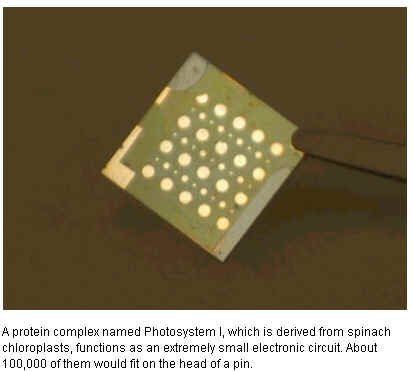
In this prototype solar cell, photosynthetic proteins
(spheres embedded in yellow peptides) absorb light and pump electrons (e-) into a silver electrode.
他のページへ トップページ ハイテク分野(目次) |
2004/9/25 朝日新聞 Science
News誌 MIT release
ホウレンソウで発電します MIT、初の光合成電池開発
http://www.asahi.com/science/update/0925/001.html
米マサチューセッツ工科大(MIT)は、ホウレンソウを使った「太陽電池」を開発したと発表した。米化学会機関誌の最新号に掲載された。発電量はまだごくわずかだが、「光合成を利用した固体電池は世界初」としている。
完成した電池は、ホウレンソウから抽出したたんぱく質をガラスと特殊な半導体で挟んだサンドイッチ構造。ガラス面に光を当てると、弱い電流が生じた。
Science News Week of June 5, 2004
Protein Power: Solar cell produces electricity from spinach and
bacterial proteins
http://www.sciencenews.org/articles/20040605/fob2.asp
Inspired by the efficiency with which plants convert sunlight into sugar, researchers have fabricated a solar cell that uses photosynthetic proteins to convert light into electricity. Although the prototype device can't yet rival commercial solar cells made of silicon, it demonstrates a new strategy for making longer-lasting photovoltaic cells.
 |
: | To make the solar cell, a team of
biologists and engineers led by Marc Baldo of the
Massachusetts Institute of Technology (MIT) harvested
photosynthetic proteins from spinach and the bacterium
Rhodobacter sphaeroides and deposited the proteins onto a
glass support. Because the proteins naturally reside in
an aqueous environment inside a cell membrane, it took
some creative chemistry to keep the approximately 2
billion isolated proteins functional on a solid surface. |
| GREEN MACHINE. In this prototype solar cell, photosynthetic proteins (spheres embedded in yellow peptides) absorb light and pump electrons (e-) into a silver electrode. |
Green, leafy
spinach may soon power more than Popeye's biceps
http://web.mit.edu/newsoffice/2004/spinach-0915.html
For the first
time, MIT researchers have incorporated a plant's ability to
convert sunlight to energy into a solid-state electronic “spinach sandwich” device that may one day power laptops and
cell phones. 
At the heart of the device is a protein complex dubbed
Photosystem I (PSI). Derived from spinach chloroplasts, PSI is 10
to 20 nanometers wide. Around 100,000 of them would fit on the
head of a pin. “They are the smallest
electronic circuits I know of,” said researcher Marc A.
Baldo, assistant professor of electronic engineering and computer
science at MIT.